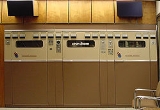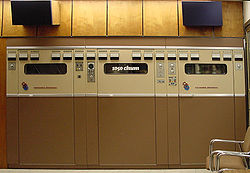
Continental Electronics
Encyclopedia
Continental Electronics is a major American
manufacturer of broadcast and military radio
transmitters, based in Dallas, Texas
. Although Continental today is best known for its FM
, shortwave
, and military VLF transmitters, Continental is most significant historically for its line of mediumwave
(AM
) transmitters, many of which are still in active service as either main transmitters or backup facilities. Among clear-channel AM stations in the U.S. and Canada, the Continental 317C was the most popular transmitter type in the 1970s and 1980s.
's radio equipment business was broken up by Federal antitrust regulators, Continental acquired the AM transmitter business, and with it the U.S. patent
on the Doherty linear RF amplifier
. Continental became part of Ling-Temco-Vought
in about 1962, the first in a series of sales which would later bring it under the control of E-Systems and then Varian Associates
in 1985. Tech-Sym acquired Continental from Varian in 1990, and then sold it to Integrated Defense Technologies in 2000. DRS Technologies
acquired IDT in 2003, and in 2005, private-equity
firm Veritas Capital (which had previously owned IDT) bought Continental back from DRS. Weldon remained with the company until his retirement in 1988.
 In 1958, Continental introduced a more-efficient Doherty-style amplifier based on a tetrode
In 1958, Continental introduced a more-efficient Doherty-style amplifier based on a tetrode
(previous Doherty designs made by Western Electric and Continental used triode
s) with the type 317B transmitter. With four subsequent revisions, more than 200 units were sold in the 317 line (a substantial number given the limited customer base for 50-kW AM transmitters in the North American market); the final revision, the 317C-3, was introduced in 1990. By this time, competitors such as Harris
had demonstrated the workability of all-solid-state 50-kW AM transmitters, which were far more energy-efficient than tube transmitters, and the North American broadcasting industry rapidly shifted away from vacuum tube
-based AM transmitters. Continental eventually dropped the 317 from its product line, but still makes transmitters using similar modified-Doherty designs for high-power longwave
and shortwave
broadcasting and military customers.
 In 1980, Continental purchased the Collins Radio line of broadcast transmitters from Rockwell International
In 1980, Continental purchased the Collins Radio line of broadcast transmitters from Rockwell International
. Collins's high-power FM transmitter, the type 831, replaced Continental's type 816 in production, and was renumbered the 816R. More than thirty variants of the 816R have been produced since 1980, and the line is still in production today.
, Harris Broadcast Communications
, and Nautel
. In the international shortwave market, Continental competes with Thomson Grass Valley
.
United States
The United States of America is a federal constitutional republic comprising fifty states and a federal district...
manufacturer of broadcast and military radio
Radio
Radio is the transmission of signals through free space by modulation of electromagnetic waves with frequencies below those of visible light. Electromagnetic radiation travels by means of oscillating electromagnetic fields that pass through the air and the vacuum of space...
transmitters, based in Dallas, Texas
Texas
Texas is the second largest U.S. state by both area and population, and the largest state by area in the contiguous United States.The name, based on the Caddo word "Tejas" meaning "friends" or "allies", was applied by the Spanish to the Caddo themselves and to the region of their settlement in...
. Although Continental today is best known for its FM
FM broadcasting
FM broadcasting is a broadcasting technology pioneered by Edwin Howard Armstrong which uses frequency modulation to provide high-fidelity sound over broadcast radio. The term "FM band" describes the "frequency band in which FM is used for broadcasting"...
, shortwave
Shortwave
Shortwave radio refers to the upper MF and all of the HF portion of the radio spectrum, between 1,800–30,000 kHz. Shortwave radio received its name because the wavelengths in this band are shorter than 200 m which marked the original upper limit of the medium frequency band first used...
, and military VLF transmitters, Continental is most significant historically for its line of mediumwave
Mediumwave
Medium wave is the part of the medium frequency radio band used mainly for AM radio broadcasting. For Europe the MW band ranges from 526.5 kHz to 1606.5 kHz...
(AM
AM broadcasting
AM broadcasting is the process of radio broadcasting using amplitude modulation. AM was the first method of impressing sound on a radio signal and is still widely used today. Commercial and public AM broadcasting is carried out in the medium wave band world wide, and on long wave and short wave...
) transmitters, many of which are still in active service as either main transmitters or backup facilities. Among clear-channel AM stations in the U.S. and Canada, the Continental 317C was the most popular transmitter type in the 1970s and 1980s.
History
Continental Electronics was founded in Dallas in 1946 by James O. Weldon, as a spin-off of the broadcast consulting business in which he was a partner, Weldon & Carr. In 1953, when Western ElectricWestern Electric
Western Electric Company was an American electrical engineering company, the manufacturing arm of AT&T from 1881 to 1995. It was the scene of a number of technological innovations and also some seminal developments in industrial management...
's radio equipment business was broken up by Federal antitrust regulators, Continental acquired the AM transmitter business, and with it the U.S. patent
Patent
A patent is a form of intellectual property. It consists of a set of exclusive rights granted by a sovereign state to an inventor or their assignee for a limited period of time in exchange for the public disclosure of an invention....
on the Doherty linear RF amplifier
Doherty amplifier
The Doherty amplifier is a modified class C radio frequency amplifier invented by William H. Doherty in 1936.The amplifier is usually configured as a grounded-cathode, carrier-peak amplifier...
. Continental became part of Ling-Temco-Vought
Ling-Temco-Vought
Ling-Temco-Vought was a large U.S. conglomerate which existed from 1969 to 2000. At its peak, its component parts were involved in the aerospace industry, electronics, steel manufacturing, sporting goods, the airline industry, meat packing, car rentals and pharmaceuticals, among other...
in about 1962, the first in a series of sales which would later bring it under the control of E-Systems and then Varian Associates
Varian Associates
Varian Associates was one of the first high-tech companies in Silicon Valley. It was founded in 1948 by Russell H. and Sigurd F. Varian, William Webster Hansen, and Edward Ginzton to sell the klystron, the first tube which could generate electromagnetic waves at microwave frequencies, and other...
in 1985. Tech-Sym acquired Continental from Varian in 1990, and then sold it to Integrated Defense Technologies in 2000. DRS Technologies
DRS Technologies
DRS Technologies, Inc. is a US-based defense contractor. Previously traded on the NYSE, the company was purchased by the Italian firm Finmeccanica in October 2008.-History:...
acquired IDT in 2003, and in 2005, private-equity
Private equity
Private equity, in finance, is an asset class consisting of equity securities in operating companies that are not publicly traded on a stock exchange....
firm Veritas Capital (which had previously owned IDT) bought Continental back from DRS. Weldon remained with the company until his retirement in 1988.

Tetrode
A tetrode is an electronic device having four active electrodes. The term most commonly applies to a two-grid vacuum tube. It has the three electrodes of a triode and an additional screen grid which significantly changes its behaviour.-Control grid:...
(previous Doherty designs made by Western Electric and Continental used triode
Triode
A triode is an electronic amplification device having three active electrodes. The term most commonly applies to a vacuum tube with three elements: the filament or cathode, the grid, and the plate or anode. The triode vacuum tube was the first electronic amplification device...
s) with the type 317B transmitter. With four subsequent revisions, more than 200 units were sold in the 317 line (a substantial number given the limited customer base for 50-kW AM transmitters in the North American market); the final revision, the 317C-3, was introduced in 1990. By this time, competitors such as Harris
Harris Corporation
Harris Corporation is a Florida-based international communications equipment company that produces wireless equipment, electronic systems, and both terrestrial and spaceborne antennas for use in the government, defense, and commercial sectors. It is also the largest private-sector employer in...
had demonstrated the workability of all-solid-state 50-kW AM transmitters, which were far more energy-efficient than tube transmitters, and the North American broadcasting industry rapidly shifted away from vacuum tube
Vacuum tube
In electronics, a vacuum tube, electron tube , or thermionic valve , reduced to simply "tube" or "valve" in everyday parlance, is a device that relies on the flow of electric current through a vacuum...
-based AM transmitters. Continental eventually dropped the 317 from its product line, but still makes transmitters using similar modified-Doherty designs for high-power longwave
Longwave
In radio, longwave refers to parts of radio spectrum with relatively long wavelengths. The term is a historic one dating from the early 20th century, when the radio spectrum was considered to consist of long, medium and short wavelengths...
and shortwave
Shortwave
Shortwave radio refers to the upper MF and all of the HF portion of the radio spectrum, between 1,800–30,000 kHz. Shortwave radio received its name because the wavelengths in this band are shorter than 200 m which marked the original upper limit of the medium frequency band first used...
broadcasting and military customers.

Rockwell International
Rockwell International was a major American manufacturing conglomerate in the latter half of the 20th century, involved in aircraft, the space industry, both defense-oriented and commercial electronics, automotive and truck components, printing presses, valves and meters, and industrial automation....
. Collins's high-power FM transmitter, the type 831, replaced Continental's type 816 in production, and was renumbered the 816R. More than thirty variants of the 816R have been produced since 1980, and the line is still in production today.
Competitors
Continental's principal competitors today in the North American domestic broadcast market include Broadcast ElectronicsBroadcast Electronics
Broadcast Electronics is a manufacturer of electronic equipment for the broadcast industry. Founded in 1959 in Silver Spring, Maryland, BE initially manufactured only endless loop cartridge "cart" machines for audio...
, Harris Broadcast Communications
Harris Corporation
Harris Corporation is a Florida-based international communications equipment company that produces wireless equipment, electronic systems, and both terrestrial and spaceborne antennas for use in the government, defense, and commercial sectors. It is also the largest private-sector employer in...
, and Nautel
Nautel
Nautel Ltd. is a Canadian manufacturer of AM and FM radio broadcast transmitters, navigational radio beacons, Differential Global Positioning System transmitters, medium frequency telegraph and NAVTEX transmitters, and high frequency amplifiers for dielectric heating applications...
. In the international shortwave market, Continental competes with Thomson Grass Valley
Grass Valley (company)
Grass Valley, previously known as Grass Valley Group, is a privately held company based in California, USA. Grass Valley produces technology for the video and broadcast industry. On January 29, 2009, Thomson announced its intention to sell the Grass Valley business unit...
.

